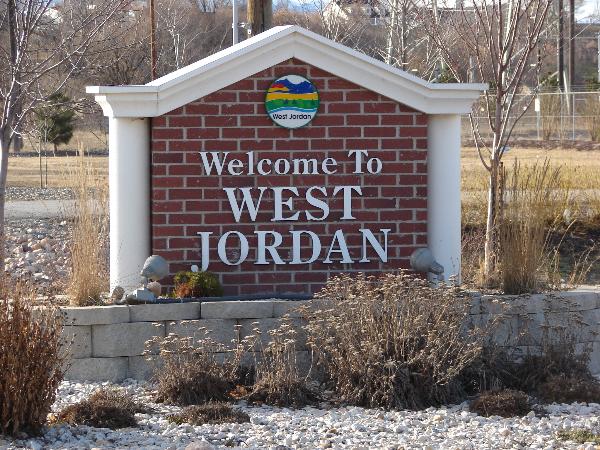
West Jordan was on of the earliest Utah pioneer settlements
after the founding of Salt Lake City. The community's roots begin
in the later part of 1849 when some pioneers began spreading out in
the Salt Lake valley. West Jordan's original unofficial area
included most of the valley on the West Side of the Jordan River,
and about a three-mile strip on the east side of the river past
State Street in an area now occupied by Midvale, Sandy and the
former Crescent area.
West Jordan's name captures some of the flavor of what the
Mormon pioneers considered their promised land. They saw strong
similarities in this arid western desert and the biblical lands.
Both contained fresh water lakes (Sea of Galilee and Utah Lake) and
dead salt water rivers (River Jordan and Utah River.) This
similarity in geological features led to this area being referred
to as a western Jordan and the southern part of the valley as the
Jordan Valley. Brigham Young reinforced this concept when he
renamed the Utah River the West Jordan River, which was shortened
through time and use to the Jordan River.
The first settlers in the present area known as West Jordan were
the Marius Ensign, Thomas Butterfield, and Samuel Egbert families.
Other settlers soon followed. In 1850 Archibald Gardner and his
brother Robert built a 2.5 mile millrace (canal) to bring water out
of the Jordan River to the area of 7800 South. The water thus
channeled was to provide a source of power for the saw mill they
built the following year. Before long the population began to
cluster near this general area and other enterprises were built and
operated such as a flour mill, woolen mill, and tannery. Many
settlers initially built dugouts to live in near the crest of the
hill overlooking the river bottoms where farming was done. Although
the original flour mill was burned by fire, it was rebuilt and
still stands. During the 1980's it was converted into a fine
furniture and delightful gift shop before a quality restaurant was
added as well as a little village complex on the adjoining
land.
About one hundred yards to the Southwest of the flour mill,
stands the first non-log chapel in Salt Lake Valley outside Salt
Lake City. It took years of construction (1861-1867) before
completion and dedication by Brigham Young. This building was known
as the Rock Meeting House. It served most of settlements in the
south end of the valley on both sides of the river and was used for
many activities besides church. In fact to help finance the roof, a
grand ball was held and officers from Fort Douglas were invited to
participate. Dancing was a favorite pastime of the pioneers. In
addition the building was used for school and other community
activities and social events. Today the structure remains basically
unchanged from the way the pioneers built it. Although the city of
West Jordan now owns the property, it is operated by The Daughters
of the Utah Pioneers, who make it available through rental to the
public. Over the past three decades, its has also been used by
other religions coming into the area. The building, now known as
Pioneer Hall, adjoins the West Jordan Cemetery, which is one of two
in the community with pioneer origins. The second is the small
Wight's Forts cemetery located on 9000 South at 3449 West.
In 1872 a major multicommunity cooperative effort was launched
to build canals throughout the valley to provide water. This in
turn provided the initial means for further growth in farming,
settlement and other related development.
West Jordan was also the site of some of the very earliest
airplane flights in the west, which commenced in 1909 and continued
through 14 March 1910. These experimental flights were made by L.
R. Culver about six years after the Wright brothers flew their
airplane at Kitty Hawk in 1903. Culver, a farmhand, built the
aircraft in a farm equipment shed near 1700 West and 9000 South. At
first a glider was constructed, then a motor was added to power the
craft. His most successful flight was about fifty feet off the
ground and lasted for about fifteen to twenty minutes.
Much of Utah's sugar beet history and production was centered in
West Jordan due to the large sugar factory built and operated in
the community for many years. West Jordan also had been known for
its fur industry, which has mostly disappeared due to
urbanization.
In the sports world, several West Jordan boxers gained national
and international recognition, ranking and titles under the
management of Marvin Jenson. Most notably native-son Gene Fullmer
twice won the World Middle Weight Boxing Championship. Other
fighters of note include AAU champions Floyd Richardson and Rex
Layne (also a top professional contender), Olympic champion Jay
Lambert, and Gene Fullmer's brother Don, who also fought for the
Middle-weight championship.
In politics, West Jordan was the home of Jean M. Westwood, when
she was chosen to chair the National Democratic party on 14 July
1972, the first woman in America to chair a major national
political party.
It was 10 January 1941 before the town of West Jordan, with a
population of less than 2,000, was officially incorporated. In the
late 1960s the community began growing at such a rate it became one
of the fastest growing small communities in the United States. By
1990 the population had reached 42,912. During this time the
community has developed a degree of economic diversity with
segments of industrial and commercial development along with its
population growth. In the process, over a dozen community parks
have been acquired and developed. This push to strengthen quality
of life for citizens is also reflected in a recent successful
proposal that brought it together with its sister city, South
Jordan, to win the location site for a new 100-acre Salt Lake
Community College campus, which will be built straddling the
cities' shared border.